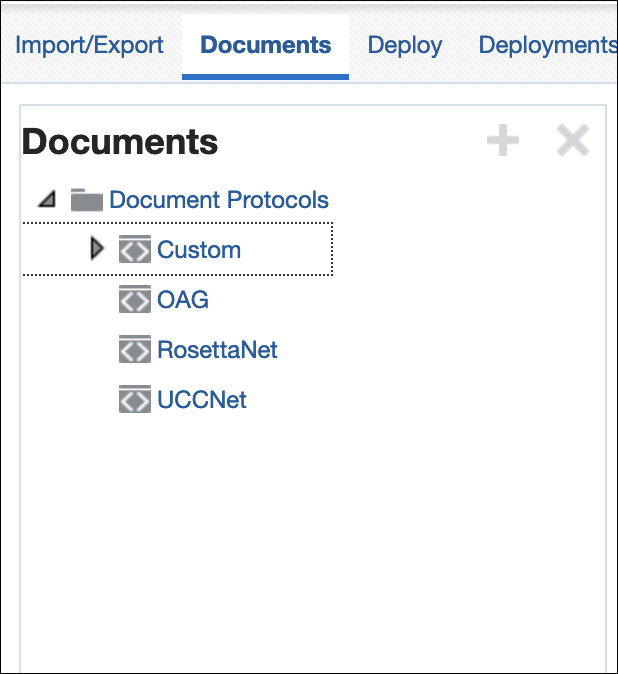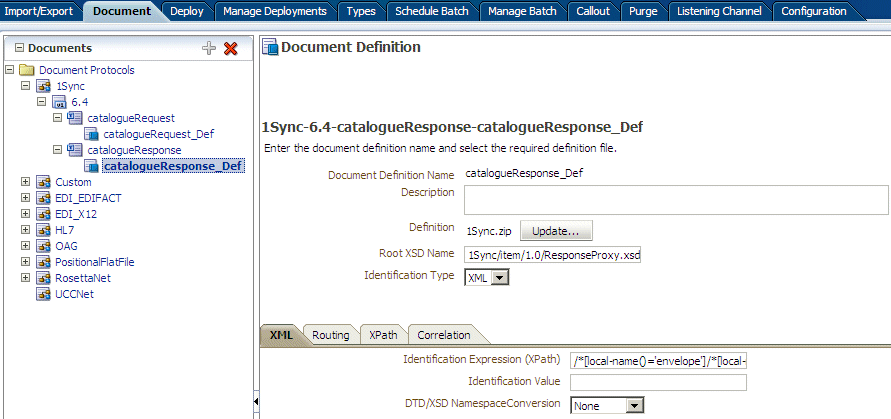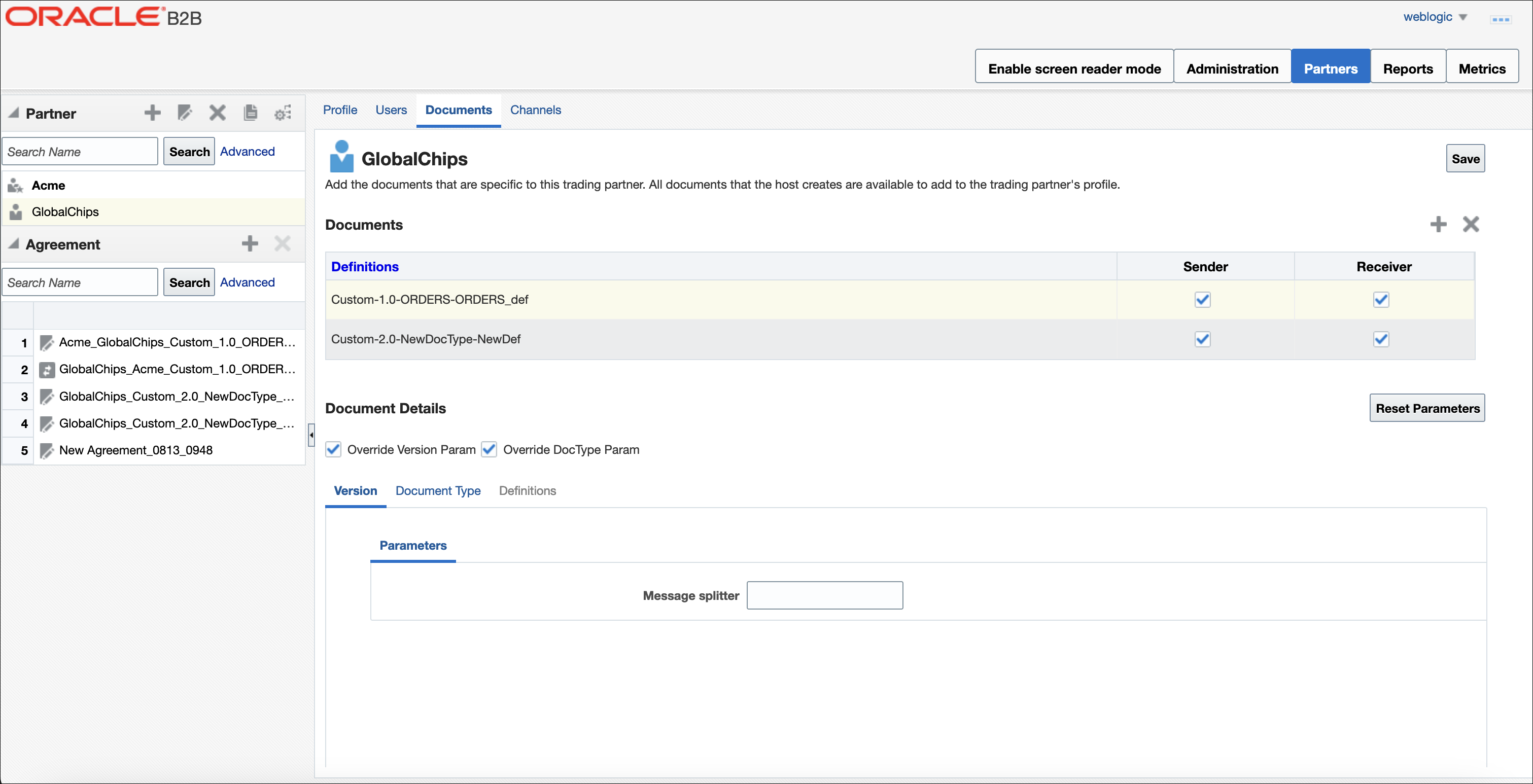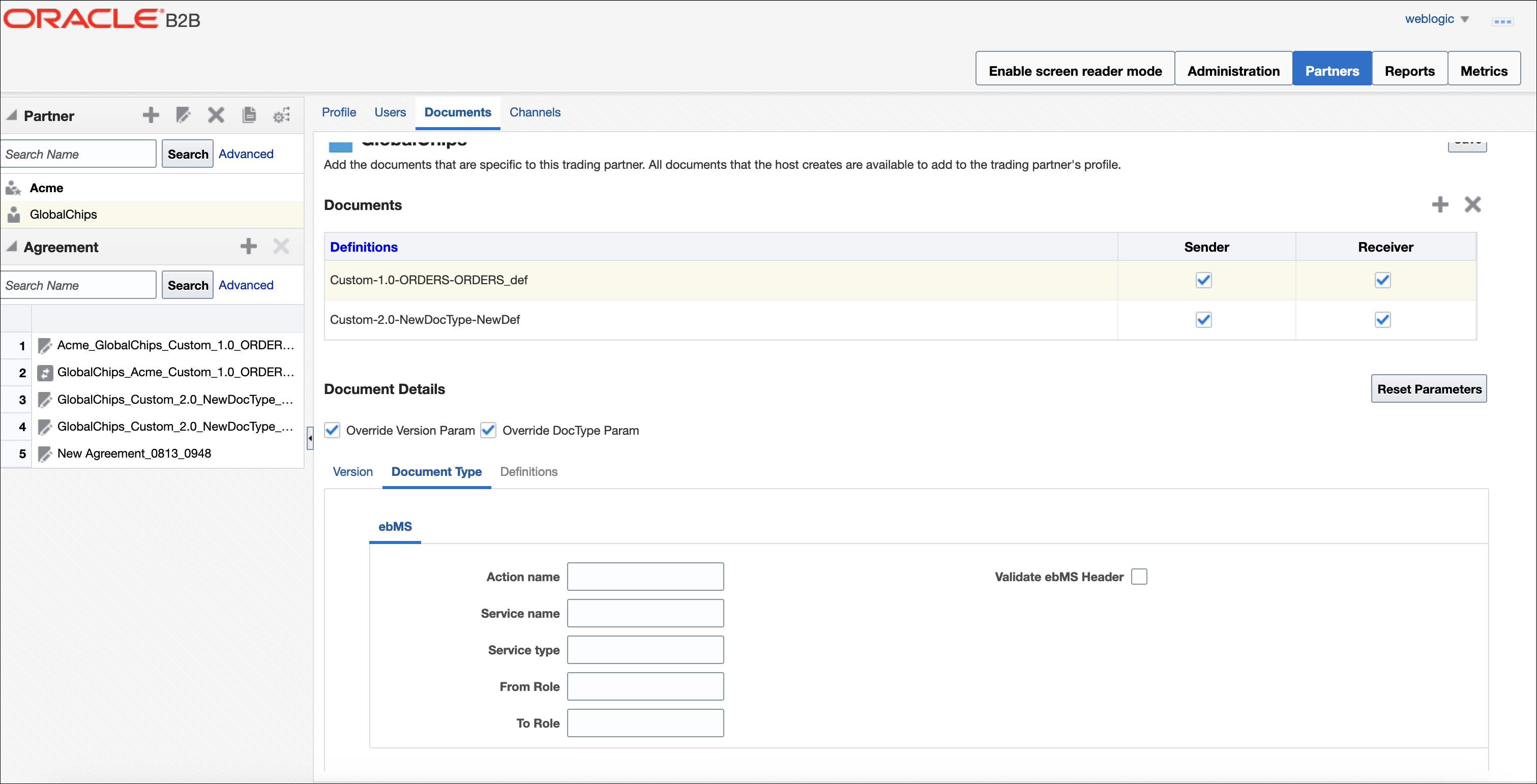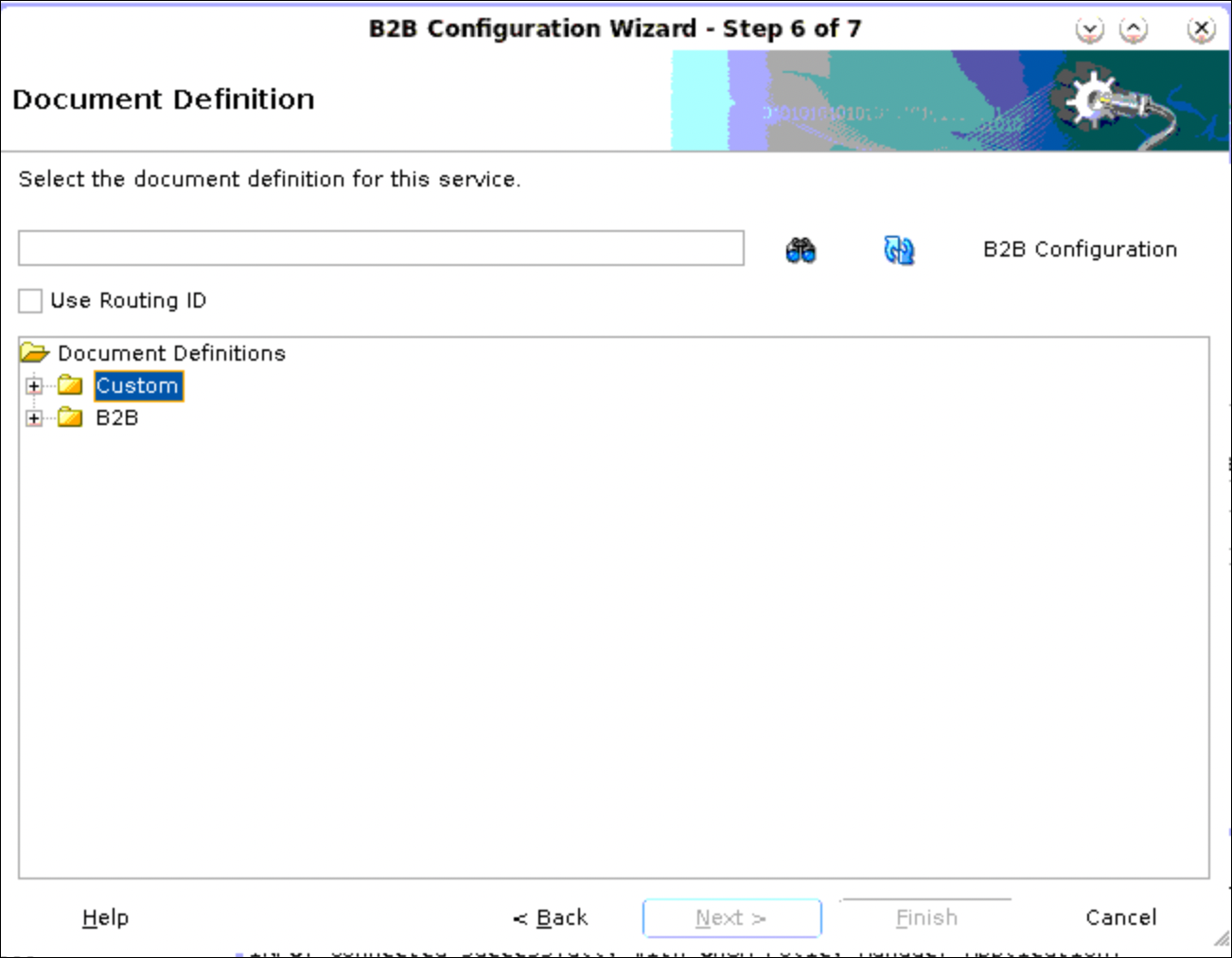8 Using Document Protocols
This chapter describes the different document protocols supported by Oracle B2B such as EDI EDIFACT, EDI X12, HL7, RosettaNet, and so on.
This chapter includes the following sections:
For related information, see the following:
Using the Custom Document Protocol
Document protocols are shown in Figure 8-1.
Oracle B2B supports custom document protocols to create documents needed for proprietary transactions. With XML messages, you have the advantage of schema enforcement (XSDs).
With non-XML messages, you can create trading partner agreements for specific message types.
When creating a Custom document, you specify rules to identify the incoming document. For XML documents, specify an XPath expression and a value, which is the expected result of the expression.
For non-XML documents such as a flat file, you can specify start and end positions or a document routing ID.
Document Version Parameters
No parameters need to be set when you create the document version for a Custom document.
Document Type Parameters
When you create a Custom document type, you can set ebXML messaging service (ebMS) parameters to identify the ebXML document. Figure 8-2 shows the document type parameters for a Custom document.
Figure 8-2 Document Type Parameters for a Custom Document
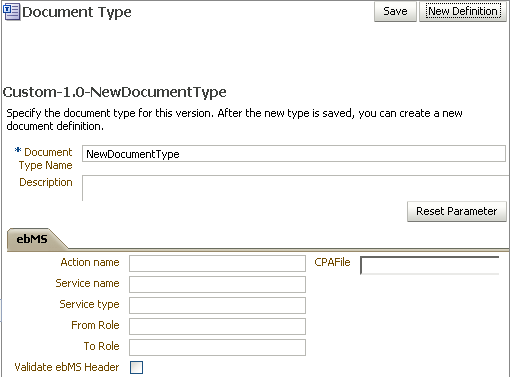
Description of "Figure 8-2 Document Type Parameters for a Custom Document"
Table 8-1 describes the document type parameters for a Custom document.
Table 8-1 Document Type Parameters for a Custom Document
| Parameter | Description |
|---|---|
|
ebMS Tab |
- |
|
Action name |
The action name for the ebXML header, which is also an identification criteria for inbound and outbound messages. ebMS documents require an action name to avoid runtime errors. |
|
Service name |
The service name for the ebXML header, which is also an identification criteria for inbound messages. ebMS documents require a service name to avoid runtime errors. |
|
Service type |
The service type for the ebXML header, which is also an identification criteria for inbound messages. ebMS documents require a service type to avoid runtime errors. |
|
From Role |
The trading partner that sends the message. A value provided here overrides the Identifiers values supplied on the Profile tab. |
|
To Role |
The trading partner that receives the message. A value provided here overrides the Identifiers values supplied on the Profile tab. |
|
Validate ebMS Header |
When selected, validates inbound ebMS header from role to role. |
|
CPA File |
CPA file |
Document Definition Parameters
When you create a Custom document definition, select the file type—XML or Flat—and set parameters in the tabbed areas. Figure 8-3 shows the document definition parameters for an XML-type Custom document.
Figure 8-3 Document Definition Parameters for an XML-Type Custom Document
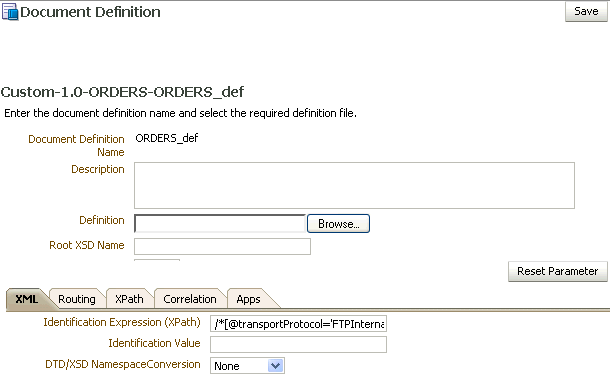
Description of "Figure 8-3 Document Definition Parameters for an XML-Type Custom Document"
Figure 8-4 shows the document definition parameters for a flat-file Custom document.
Figure 8-4 Document Definition Parameters for a Flat-FIle Custom Document
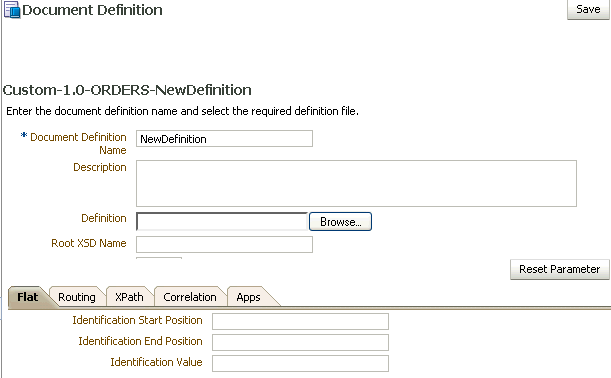
Description of "Figure 8-4 Document Definition Parameters for a Flat-FIle Custom Document"
Table 8-2 describes the document definition parameters for a Custom document.
Table 8-2 Document Definition Parameters for a Custom Document
| Parameter | Description |
|---|---|
|
XML Tab |
(Available if XML is selected from Identification Type) |
|
Identification Expression (XPath) |
Locates a node in the XML payload |
|
Identification Value |
Provides the value to match in the node identified by the Identification Expression. If the values match, then the document is successfully identified. If the value is left blank, then Oracle B2B checks for the existence of the node and the document is successfully identified. |
|
DTD/XSD NamespaceConversion |
Select from None, Both, Inbound, or Outbound. |
|
Routing Tab |
- |
|
Document Routing ID |
Sets the consumer name to the back-end application |
|
XPath Tab |
For more information, see How to Configure the XPath Expression for a Custom XML Document |
|
XPath Name1 |
The XML XPath name for retrieving the value from the payload |
|
XPath Expression1 |
The XML XPath expression for retrieving the value from the payload (see Note below table) |
|
XPath Name2 |
The XML XPath name for retrieving the value from the payload |
|
XPath Expression2 |
The XML XPath expression for retrieving the value from the payload (see Note below table) |
|
XPath Name3 |
The XML XPath name for retrieving the value from the payload |
|
XPath Expression3 |
The XML XPath expression for retrieving the value from the payload (see Note below table) |
|
Correlation Tab |
- |
|
Correlation From XPath Name |
The name of the correlation property for initiating the correlation. |
|
Correlation From XPath Expression |
The XML XPath for retrieving the value from the payload to initiate the correlation. (see Note below table) |
|
Correlation To XPath Name |
The name of the correlation property for the correlation. |
|
Correlation To XPath Expression |
The XML XPath for retrieving the value from the payload for the correlation. (see Note below table) |
|
Flat Tab |
- |
|
Identification Start Position |
Used in combination with the end position to retrieve a value from the payload between the start and end positions |
|
Identification End Position |
Used in combination with the start position to retrieve a value from the payload between the start and end positions |
|
Identification Value |
A value between the start and end positions |
|
Apps Tab |
- |
|
Document |
The name of the internal application document. |
|
Action |
A sub-classification within the document. |
|
XSLTFile |
The name of the XSLT file. |
Note:
When using EDI documents which have default namespace, the usage of
//*[local-name()='...']
can be used, but the more common usage
//Segment-TH/Field-101-A1/text()
cannot be used.
How to Configure the XPath Expression for a Custom XML Document
The XPath expression identifies a Custom XML document. You configure the XPath expression when you specify the document type parameters.
The options when configuring an XPath expression are:
Option 1: Specify the XPath and the Matching Value
Assume that the transaction ID is 12345. Set the parameters as follows:
| Field | Value |
|---|---|
|
Identification Value |
12345 |
|
Identification Expression |
//*[local-name() = 'TransactionID']/text() |
Oracle B2B compares the value of Identification Expression in the payload to the value specified in Identification Value. If the values match, then the document is identified successfully and the corresponding document type and document protocol version are used to identify the agreement. Example 8-1 shows an excerpt of the XML payload for this option.
Example 8-1 Specify the XPath and the Matching Value
<?xml version="1.0" encoding="UTF-8" ?>
<Message xmlns:ns1="http://www.example1.org" xmlns:ns2="http://www.example2.org"
xmlns="http://www.example3.org"
xmlns:xsi="http://www.w3.org/2001/XMLSchema-instance"
xmlns:ns="http://www.example4.org">
<MessageHeader>
<Source>201944019</Source>
<Destination>205704856</Destination>
<TransactionID>123456</TransactionID>
<Version>1-0-0</Version>
</MessageHeader>
<Body>
<ns:Case xsi:schemaLocation="http://www.example4.org" ns1:caseCategoryID="1">
<ns1:OfficialProvisionNumber>String</ns1:OfficialProvisionNumber>
</ns:Case>
</Body>
</Message>Option 2: Check for the Existence of a Node
Assume that you are checking for the existence of a node called registerCommand. Set the parameters as follows:
| Field | Value |
|---|---|
|
Identification Value |
Leave blank. |
|
Identification Expression |
/*[local-name()='envelope']/body/transaction/command/*[local-name()='registerCommand'] |
When the Identification Value field is left blank, Oracle B2B checks for the node identified in Identification Expression. If a node in the payload matches, then the document is identified successfully. Example 8-2 shows an excerpt of the XML payload for this option.
Example 8-2 Check for the Existence of a Node
<uccnet:envelope xmins:eanucc="http://www.ean-ucc.org/schemas/1.3/eanucc"
xmlns:xsi="http://www.w3.org/2001/XMLSchema-instance"
xmlns:uccnet="http://www.uccnet.org/schemas/2.2/uccnet"
communicationVersion="2.2"
xsi:schemaLocation="http://www.uccnet.org/schemas/2.2/uccnet
http://www.testregistry.net/xmlschema/uccnet/2.2/Envelope.xsd">
<messageHeader>
<messageIdentifier>
<value>791:1_EB3CDC749A1F2BABE03014906CC4605A</value>
</messageIdentifier>
<userId>oraclesupXSD</userId>
<representingParty>
<gin>0060974050142</gin>
</representingParty>
</messageHeader>
<body>
<transaction>
<entityIdentification>
<uniqueCreatorIdentification>856</uniqueCreatorIdentification>
<globalLocationNumber>
<gin>0060974050142</gin>
</globalLocationNumber>
</entityIdentification>
<command>
<uccnet:registerCommand>
<registerCommandHeader type="ADD" />
</uccnet:registerCommand>
</command>
</transaction>
</body>
</uccnet:envelope>Option 3: Check the Value of an Attribute
Assume that the value of the country attribute is US. Set the parameters as follows:
| Field | Value |
|---|---|
|
Identification Value |
US |
|
Identification Expression |
//*/@country |
Oracle B2B compares the value of the country attribute to the value set for Identification Value. If the values match, then the document is identified successfully. Example 8-3 shows an excerpt of the XML payload for this option.
Example 8-3 Check the Value of an Attribute
<?xml version="1.0" encoding="windows-1252" ?>
<MyAddress country="US" xmlns="http://www.example.org"
xmlns:xsi="http://www.w3.org/2001/XMLSchema-instance"
xsi:schemaLocation="PO.xsd">
<name>B2B Buyer</name>
<street>100 Oracle Parkway</street>
<city>Redwood City</city>
<state>CA</state>
<zip>94065</zip>
</MyAddress>Using the OAG Document Protocol
Oracle B2B implements Open Applications Group (OAG) standards, a robust XML standard used across many industries. This standard defines messages as business object documents (BODs).
For information about the organization that created and maintains the OAG standards, go to http://www.oagi.org.
Document Version Parameters
No parameters need to be set when you create the document version for an OAG document.
Document Type Parameters
When you create an OAG document type, you can set various parameters. Figure 8-5 shows the document type parameters for an OAG document.
Figure 8-5 Document Type Parameters for an OAG Document
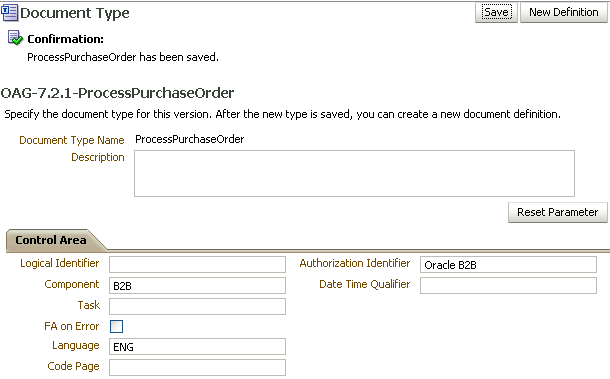
Description of "Figure 8-5 Document Type Parameters for an OAG Document"
Table 8-3 describes the document type parameters for an OAG document.
Table 8-3 Document Type Parameters for an OAG Document
| Parameter | Description |
|---|---|
|
Control Area Tab |
- |
|
Logical Identifier |
Logical Identifier |
|
Component |
Component |
|
Task |
Task |
|
FA on Error |
When enabled, CONFIRMATION flag is set to 1. |
|
Language |
Language |
|
Code Page |
Code Page |
|
Authorization Identifier |
Authorization Identifier |
|
Date Time Qualifier |
Date Time Qualifier attribute |
Document Definition Parameters
When you create an OAG document definition, you can set various parameters. Figure 8-6 shows document definition parameters for an OAG document.
Figure 8-6 Document Definition Parameters for an OAG Document

Description of "Figure 8-6 Document Definition Parameters for an OAG Document"
Table 8-4 describes the document definition parameters for an OAG document.
Table 8-4 Document Definition Parameters for an OAG Document
| Parameter | Description |
|---|---|
|
XML Tab |
- |
|
Identification Expression (XPath) |
Locates a node in the XML payload. |
|
Identification Value |
Provides the value to match in the node identified by the identification expression. If the values match, then the document is successfully identified. If the value is left blank, then Oracle B2B checks for the existence of the node and the document is successfully identified. |
|
DTD/XSD Namespace Conversion |
Select from None, Both, Inbound, or Outbound. |
|
Routing Tab |
- |
|
Document Routing ID |
Sets the consumer name to the back-end application. |
|
XPath Tab |
For more information, see How to Configure the XPath Expression for a Custom XML Document. |
|
XPath Name1 |
The XML XPath name for retrieving the value from the payload. |
|
XPath Expression1 |
The XML XPath expression for retrieving the value from the payload. |
|
XPath Name2 |
The XML XPath name for retrieving the value from the payload. |
|
XPath Expression2 |
The XML XPath expression for retrieving the value from the payload. |
|
XPath Name3 |
The XML XPath name for retrieving the value from the payload. |
|
XPath Expression3 |
The XML XPath expression for retrieving the value from the payload. |
|
Correlation Tab |
- |
|
Correlation From XPath Name |
The name of the correlation property for initiating the correlation. |
|
Correlation From XPath Expression |
The XML XPath for retrieving the value from the payload to initiate the correlation. |
|
Correlation To XPath Name |
The name of the correlation property for the correlation. |
|
Correlation To XPath Expression |
The XML XPath for retrieving the value from the payload for the correlation. |
|
Apps Tab |
- |
|
Document |
The name of the internal application document. |
|
Action |
A sub-classification within the document. |
|
XSLTFile |
The name of the XSLT file. |
Using the RosettaNet Document Protocol
A RosettaNet DTD, when used with Oracle B2B in a SOA composite application, must be converted to an XSD. An AQ Adapter added to the composite application can convert the inbound DTD to an XSD and manipulate the data as needed. Likewise, the AQ Adapter can convert the outbound XSD to a DTD for Oracle B2B to send the message out.
RosettaNet standards are specified by using of the RosettaNet Partner Interface Process (PIP), RosettaNet Dictionaries, and RNIF. Oracle B2B supports all PIPs. (The RosettaNet Technical Dictionary is not supported in Oracle B2B.)
PIPs
A PIP is an XML-based dialog that defines the business processes between trading partners. It defines the structure, sequence of steps, roles (buyer and seller) activities, data elements, values, and value types for each business document message exchanged between trading partners.
Using PIP 3A4 as an example, you can see how a PIP defines a dialog between trading partners, as shown in Figure 8-7.
Figure 8-7 PIP 3A4 Message Exchange Between Buyer and Seller
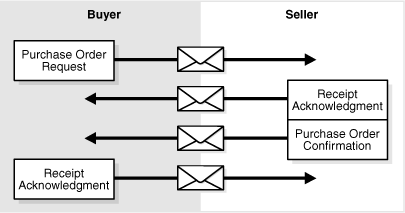
Description of "Figure 8-7 PIP 3A4 Message Exchange Between Buyer and Seller"
A PIP sequence combines a cluster, segment, and type. The PIP sequence 3A4, for example, encodes the information shown in Table 8-5.
Table 8-5 PIP 3A4 Breakdown
| Element | Description |
|---|---|
|
3 |
Order manage cluster, with which trading partners can:
|
|
3A |
Quote and order entry segment. |
|
3A4 |
Specific PIP type, which supports:
|
Document Version Parameters
No parameters need to be set when you create the document version for a RosettaNet document.
Document Type Parameters
When you create a RosettaNet document type, you can set various parameters. Figure 8-8 shows document type parameters for a RosettaNet document.
Figure 8-8 Document Type Parameters for a RosettaNet Document
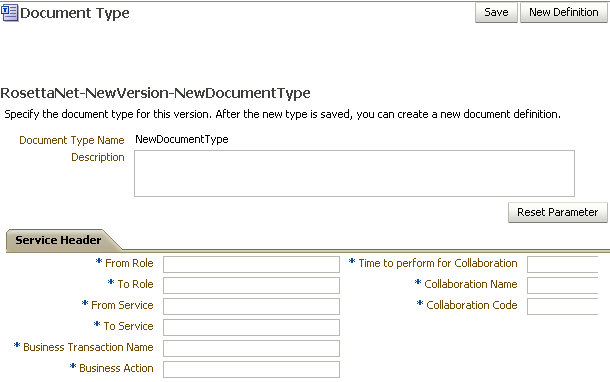
Description of "Figure 8-8 Document Type Parameters for a RosettaNet Document"
Table 8-6 describes document type parameters for a RosettaNet document.
Table 8-6 Document Type Parameters for a RosettaNet Document
| Parameter | Description |
|---|---|
|
Service Header Tab |
- |
|
*From Role |
The trading partner that sends the message (in Partner Role Description of the PIP). |
|
*To Role |
The trading partner that receives the message (the role the trading partner receiving the message plays in the PIP). |
|
*From Service |
The service that sends the message. |
|
*To Service |
The service to which the message is sent. |
|
*Business Transaction Name |
The name of the business transaction is required. |
|
*Business Action |
The name of the business action is required. The value must be consistent with the Global Business Action Code. |
|
*Time to Perform for Collaboration |
The time to perform the business action is required. |
|
*Collaboration Name |
The RosettaNet collaboration name signifies the business transaction between trading partners (the roles as buyer and seller) depending on a common transaction. Required. |
|
*Collaboration Code |
The textual form of the abbreviated collaboration name. Required. |
Document Definition Parameters
When you create a RosettaNet document definition, you can set various parameters. Figure 8-9 shows the document definition parameters for a RosettaNet document.
Figure 8-9 Document Definition Parameters for a RosettaNet Document
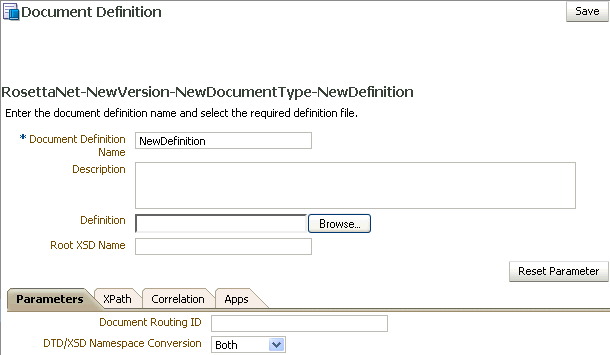
Description of "Figure 8-9 Document Definition Parameters for a RosettaNet Document"
Table 8-7 describes the document definition parameters for a RosettaNet document.
Table 8-7 Document Definition Parameters for a RosettaNet Document
| Parameter | Description |
|---|---|
|
Parameters Tab |
- |
|
Document Routing ID |
Sets the consumer name to the back-end application. |
|
DTD/XSD Namespace Conversion |
A converted document can optionally replace the original RosettaNet document. Select Both to replace the RosettaNet document with the converted document for both the inbound and outbound messages. Select Inbound to replace the RosettaNet document with the converted document for the inbound message. Select Outbound to replace the RosettaNet document with the converted document for the outbound message. Select None for no replacement. None passes the DTD instance as-is. Inbound converts the instance DTD to XSD. Outbound converts the instance XSD to DTD. Both convert both inbound and outbound formats. |
|
XPath Tab |
For more information, see How to Configure the XPath Expression for a Custom XML Document. |
|
XPath Name1 |
The XML XPath name for retrieving the value from the payload. |
|
XPath Expression1 |
The XML XPath expression for retrieving the value from the payload. |
|
XPath Name2 |
The XML XPath name for retrieving the value from the payload. |
|
XPath Expression2 |
The XML XPath expression for retrieving the value from the payload. |
|
XPath Name3 |
The XML XPath name for retrieving the value from the payload. |
|
XPath Expression3 |
The XML XPath expression for retrieving the value from the payload. |
|
Correlation Tab |
Correlation is required for a two-action PIP, for example, a 3A4. |
|
Correlation From XPath Name |
The name of the correlation property for initiating the correlation. For example, |
|
Correlation From XPath Expression |
The XML XPath for retrieving the value from the payload to initiate the correlation. |
|
Correlation To XPath Name |
The name of the correlation property for the correlation. Correlation-to represents the other message that takes part in the correlation. For example, |
|
Correlation To XPath Expression |
The XML XPath for retrieving the value from the payload for the correlation. |
|
Apps Tab |
- |
|
Document |
The name of the internal application document. |
|
Action |
A sub-classification within the document. |
|
XSLTFile |
The name of the XSLT file. |
Using the partnerDefinedPIPPayloadBindingId and LocationId Service Header Parameters
Oracle B2B provides support for the following Service Header parameters:
-
partnerDefinedPIPPayloadBindingID
-
LocationID
Configuring partnerDefinedPIPPayloadBindingID
You can configure the partnerDefinedPIPPayloadBindingID parameter by using the Service Header section under DocumentType in the Oracle B2B console.
Configuring locationID
To configure Rosettanet sender and receiver LocationID using the Oracle B2B console:
RosettaNet Validation
RosettaNet validation compares the elements in RosettaNet XML-format business documents to the requirements specified in the RosettaNet Message Guideline specification to determine their validity. This specification defines requirements for details such as element data types, element lengths, element value lists, and element cardinality. PIPs that require RosettaNet dictionary validation are also validated when a dictionary is present.The minimum validation-level requirements on the sections of a RosettaNet XML-format business document are as follows. These requirements cover the preamble, delivery header, service header, and service content sections of a document. Documents not following one or more of these requirements are identified as invalid.
- The XML-format business document requires compliance with its DTD.
- Elements with data types, lengths, or both that are specified in the RosettaNet Message Guideline specification require validation against this specification.
- An element's list of values specified in the entity instance list in the corresponding RosettaNet Message Guideline specification requires validation against this specification.
- If the Message Guideline specification defines the cardinality specification of an element differently from the corresponding DTD specification, the Message Guideline specification takes precedence.
- If a PIP requires dictionary validation, and a dictionary is included, the service content requires validation against the dictionary as a part of action performance.
- Cross-tag validation is based on message guidelines.
Using the UCCNet Document Protocol
Oracle B2B implements UCCNet, which enables trading partners—typically retailers and suppliers in the retail and consumer goods industries—to exchange documents with UCCNet.
The UCCNet document types supported in Oracle B2B are list below.
-
registerCommand
-
confirmCommand
-
linkCommand
-
checkComplianceCommand
-
documentCommand
-
documentIdentificationCommand
-
notificationStateCommand
-
queryCommand
-
registerLinkCommand
-
publicationCommand
-
publishCommand
-
catalogueItemMaintenanceCommand
-
priceCommand
-
validateCommand
-
registerOwnershipCommand
-
subscriptionCommand
-
notifyCommand
-
response
Document Version Parameters
No parameters need to be set when you create the document version for a UCCNet document.
Document Type Parameters
No parameters need to be set when you create the document type for a UCCNet document.
Document Definition Parameters
When you create a UCCNet document definition, you can set various parameters. Figure 8-10 shows document definition parameters for a UCCNet document.
Figure 8-10 Document Definition Parameters for a UCCNet Document
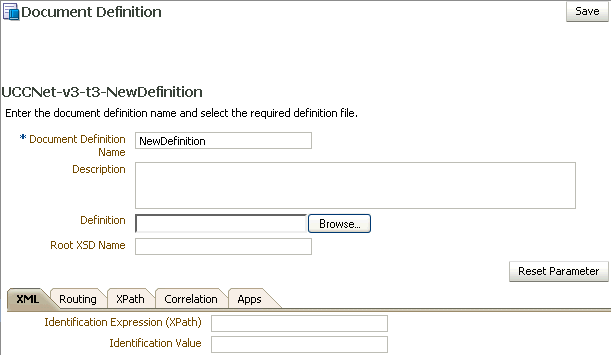
Description of "Figure 8-10 Document Definition Parameters for a UCCNet Document"
Table 8-8 describes the document definition parameters for a UCCNet document.
Table 8-8 Document Definition Parameters for a UCCnet Document
| Parameter | Description |
|---|---|
|
XML Tab |
The following parameters are on the XML tab. |
|
Identification Expression (XPath) |
Locates a node in the XML payload |
|
Identification Value |
Provides the value to match in the node identified by the Identification Expression. If the values match, then the document is successfully identified. If the value is left blank, then Oracle B2B checks for the existence of the node and the document is successfully identified. |
|
Routing Tab |
The following parameters are on the Routing tab. |
|
Document Routing ID |
Sets the consumer name to the back-end application. |
|
XPath Tab |
For more information, see How to Configure the XPath Expression for a Custom XML Document. |
|
XPath Name1 |
The XML XPath name for retrieving the value from the payload. |
|
XPath Expression1 |
The XML XPath expression for retrieving the value from the payload. |
|
XPath Name2 |
The XML XPath name for retrieving the value from the payload. |
|
XPath Expression2 |
The XML XPath expression for retrieving the value from the payload. |
|
XPath Name3 |
The XML XPath name for retrieving the value from the payload. |
|
XPath Expression3 |
The XML XPath expression for retrieving the value from the payload. |
|
Correlation Tab |
The following parameters are on the Correlation tab. |
|
Correlation From XPath Name |
The name of the correlation property for initiating the correlation. |
|
Correlation From XPath Expression |
The XML XPath for retrieving the value from the payload to initiate the correlation. |
|
Correlation To XPath Name |
The name of the correlation property for the correlation. |
|
Correlation To XPath Expression |
The XML XPath for retrieving the value from the payload for the correlation. |
|
Apps Tab |
The following parameters are on the Apps tab. |
|
Document |
The name of the internal application document. |
|
Action |
A sub-classification within the document. |
|
XSLTFile |
The name of the XSLT file. |
Creating a 1Sync Document
The 1Sync document protocol helps in the data synchronization between seller and buyer, which enables the transfer of product and location information with the continuous synchronization of the data over time.
Use the Custom document protocol or the UCCNet document protocol to create a 1Sync XML document.
Note:
The GS-1 organization has changed the standard name from UCCNet to 1Sync. Use either the seeded UCCNet document protocol or create a new Custom document protocol, 1Sync, as illustrated in the figure. The functionality is the same.
Figure 8-11 shows a document definition for a 1Sync document, using the Custom document protocol.
You can correlate 1Sync request and response messages as follows:
-
Use the document routing ID on the Routing tab. The routing ID 1Sync_64_catalogueRequest is shown Figure 8-12.
Figure 8-12 The Routing Tab for a 1Sync Document Definition
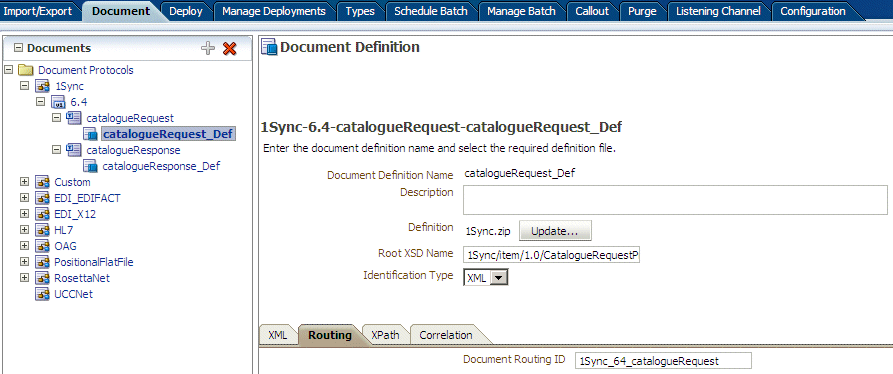
Description of "Figure 8-12 The Routing Tab for a 1Sync Document Definition" -
Use correlation parameters on the Correlation tab. The following parameters and values are shown in Figure 8-13.
-
Correlation From XPath Name:
From_catalogueRequest_messageId -
Correlation From XPath Expression:
/*[local-name()='envelope']/*[local-name()='header']/*[local-name()='messageId']This value matches the correlationFrom value in the payload.
Figure 8-13 The Correlation Tab for a 1Sync Document Definition

Description of "Figure 8-13 The Correlation Tab for a 1Sync Document Definition"
-
For more information, see Using the Custom Document Protocol.
Changing Document Details
For more information, see Restricting Access to Document Types.
Figure 8-14 shows the Version tab in the Document Details section, where parameters for the document protocol version can be changed.
Figure 8-15 shows the Document Type tab, where parameters for the document type can be changed.
Use the Override Version Param and Override DocType Param parameters to indicate that override values are provided. Document type parameter values set for a remote trading partner take precedence over the default document type parameter values set for the document definition when the document was created on the Administration > Document tab.
To override document details:
Changing Document Definitions After Deploying an Agreement
Changes to a document definition after an agreement is deployed are not reflected in the trading partner's profile. Use the Document Details area on the Partners > Documents tab to change document protocol version and document type parameters. Then redeploy the agreement.
Changing Document Definitions After Importing Metadata
If you import B2B metadata and then change the document from the Administration > Document tab, then you must also make the same changes to the supported document definition for the host and remote trading partners from the Partners > Documents tab. Use the Version, Document Type, and Definitions tabs under Document Details to make the changes.
Using Document Routing IDs
This is useful if you have many different document definitions, but you want them to be handled the same way. The WSDL uses the document routing ID instead of the document definitions. In a SOA composite application, the B2B Configuration Wizard provides an option to use the document routing ID instead of selecting a document definition, as shown in Figure 8-16.
Figure 8-16 Document Routing ID Option in Oracle JDeveloper
When using AQ, if you set the routing ID value instead of using the default b2buser, then do not set it to a numeric value. Use a combination of alphabetic and numeric values.
